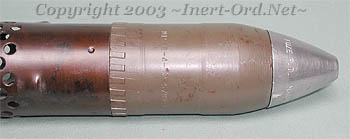
Range = 4300yds
Overall weapon length was approx. 60in.
Weight = 45lbs
The first recoilless gun was developed during WWI by Commander Davis of the US Navy. It consisted of two gun barrels pointing in opposite directions connected to a common chamber. One barrel was loaded with the projectile, the other with an equal mass of small lead shot encased in grease. The propellant cartridge was placed in the central chamber and when fired the projectile and the "countershot" shot out both ends at equal velocities, leaving the gun static with no imparted recoil. The lead shot and grease quickly dispersed and lost energy, while the service projectile proceeded on to the target. This concept was developed for use in aircraft armament for attacking submarines but never used in combat.
The concept continued to be explored and soon it was realized the countershot could be eliminated, substituting the gas from the propellant as long as it was of sufficient speed and mass.
The attraction of a recoilless weapon is that a much lighter light artillery piece of a given caliber can be created, as it eliminates the need for the massive recoil mechanisms required for conventional artillery. In the case of the 57mm anti-tank gun this was a huge difference. Recoilless weapons found a perfect application with airborne infantry.
The major drawback is these weapons use a huge amount of propellant, four-fifths of the charge is exhausted from the jet. The back blast is also a significant hazard as well as a bright illuminating source, which gives away the position of the gun.
The concept was developed in various forms by the Germans, British and Americans.
 57mm Recoilless H.E. Round
57mm Recoilless H.E. RoundThe M18 was provided with two types of ammunition, High Explosive (shown here), and a HEAT round.
Both used an interesting pre-grooved rifling design. This allowed the projectile to accelerate faster as no extra force is required to engage a solid driving band. Proper head space for the cartridge is determined by three raised protrusions on the casing right in front of the perforations in the cartridge.
